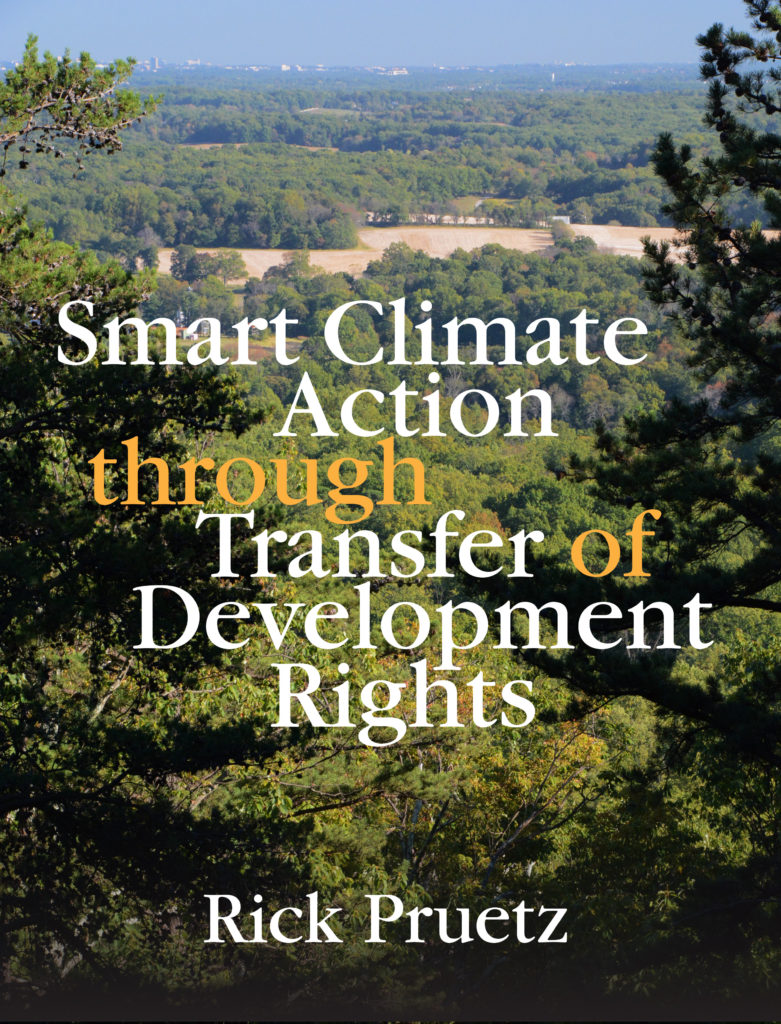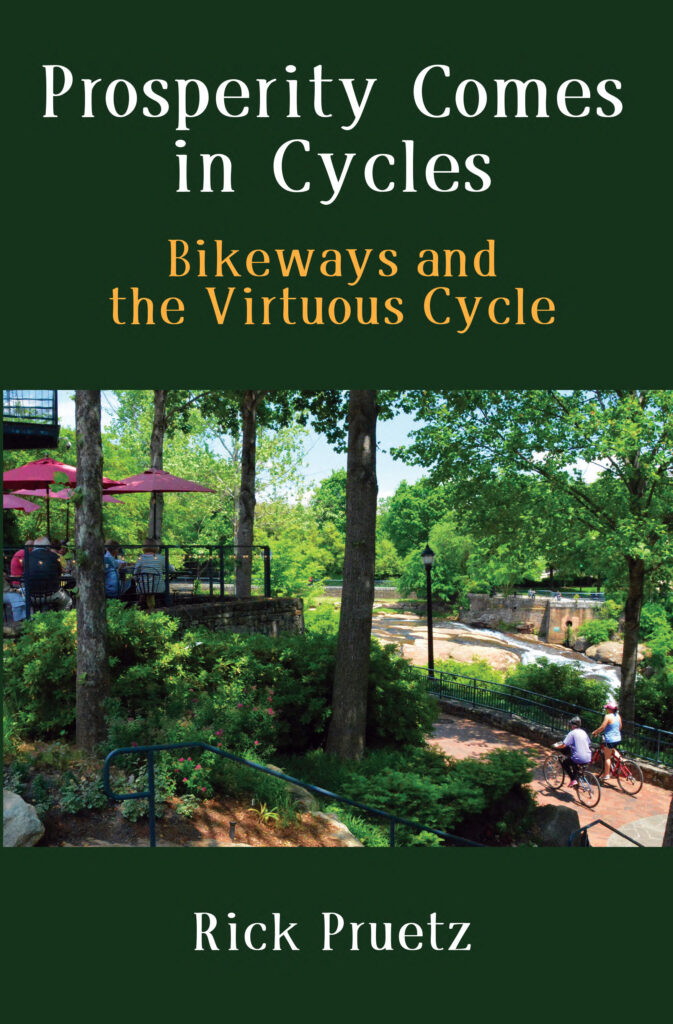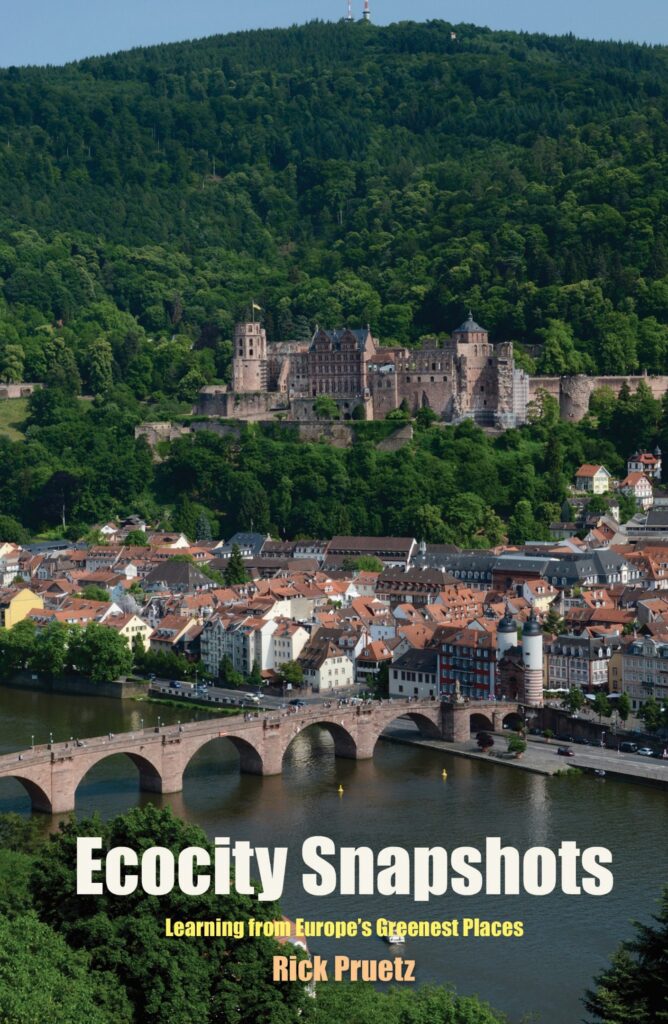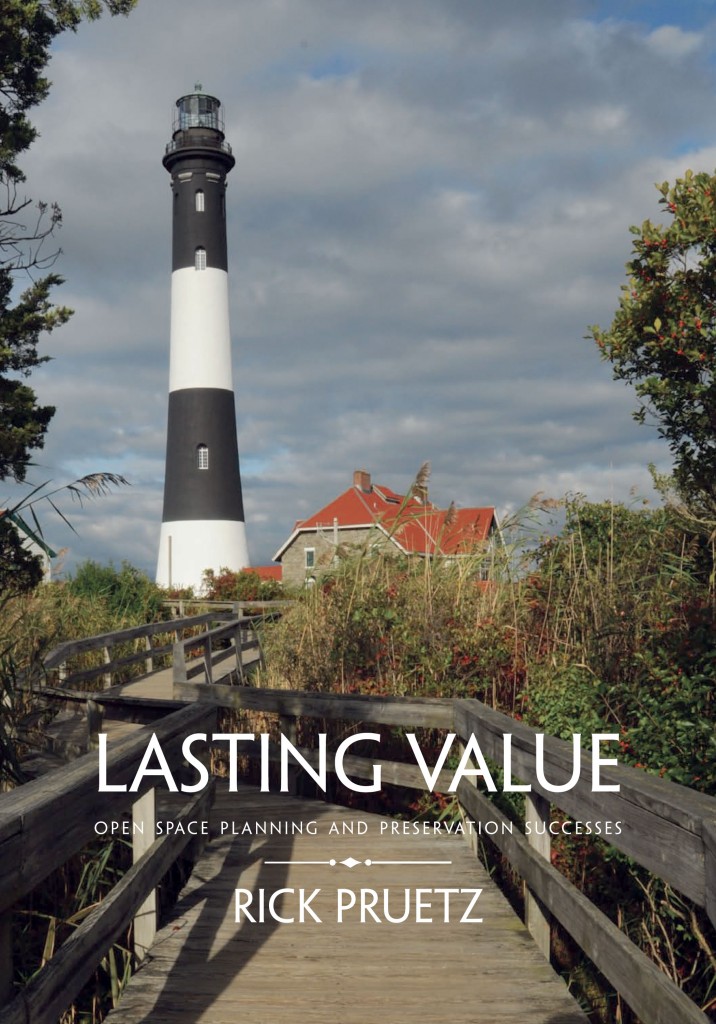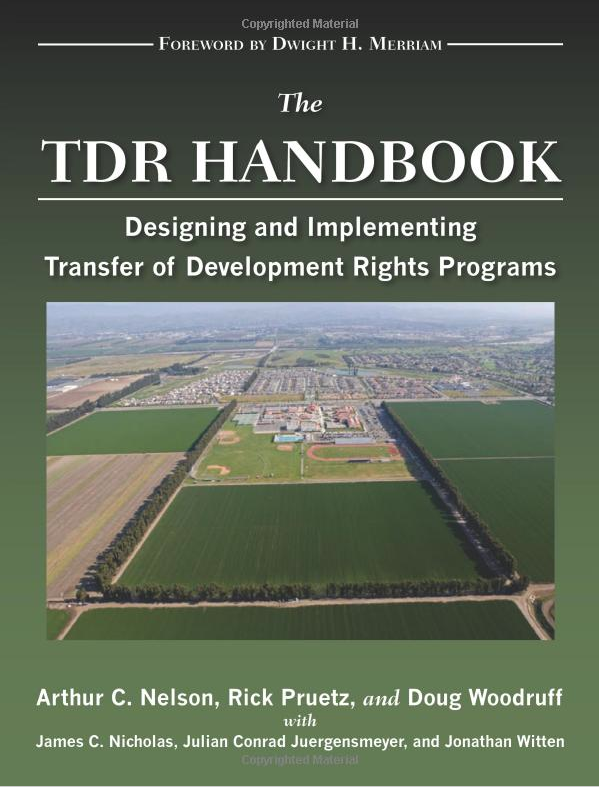Books
Smart Climate Action through Transfer of Development Rights
Rick Pruetz, FAICP
Arje Press, September 2021
Paperback (209 pages) and Kindle
Available through Amazon
Land use is essential to climate action. We need diverse, compact communities where people can meet their daily needs without a car. We need to preserve our farms, forests, and wetlands, as well as maximize their ability to sequester carbon. We need to secure the embedded energy in older buildings, safeguard our water, restore biodiversity, and adapt to the growing threat from wildfires, floods, and sea level rise. By accomplishing any one of these goals, we often receive many other benefits in addition to the mitigation of greenhouse gases and adaptation to the growing threats of climate change.
Transfer of development rights, or TDR, is a cost-effective way of steering growth away from places needed for climate action and into locations where development can be safely and efficiently accommodated. Unlike other preservation tools, TDR is primarily powered by private sector profits rather than taxation. In addition, jurisdictions themselves can engage in the TDR process to transform a limited investment into a perpetual revolving fund for preservation.
Smart Climate Action profiles 282 TDR programs and highlights how this market-based tool can and has been used to preserve greenbelts, forests, farms, wetlands, and landmarks as well as reduce vulnerability to wildfire, floods, sea level rise, and water scarcity. Developing a successful TDR program requires extensive community engagement and political will. However, the cost of using TDR for climate action remains much lower than the cost of inaction.
Prosperity Comes in Cycles: Bikeways and the Virtuous Cycle
Rick Pruetz
Arje Press, 2021
Paperback (228 pages)
Available through Amazon
Bicycle trails are good for business. They attract restaurants, brewpubs, and retail shops catering to those who walk or pedal for fun, exercise, health, and to get from place to place. When trails connect centers of employment, recreation, education and culture, they also generate residential development aimed at people who increasingly prefer active transportation to fighting traffic. And when trails are extended and linked with one another, they expand tourism revenue from a growing breed of vacationers who want to get out of their cars and experience places at a more leisurely and enjoyable speed.
As bicycle trails succeed, they increase business activity, employment, income, property value, and tax revenues in a self-reinforcing upward spiral, motivating additional trail improvements, boosting trail use, growing more trail-adjacent businesses, expanding property investments, enlarging tax revenues, generating public support for further trail improvements, and creating, pardon the pun, a virtuous cycle.
Prosperity Comes in Cycles synthesizes numerous studies documenting the success of bikeways and multi-use trails in reducing energy consumption, pollution, transportation costs, and healthcare expenses while increasing economic activity, employment, income, property value, and tax revenues. Summaries of first-hand visits to bikeways in 51 places located in the US and Canada illustrate how communities are expanding trail systems and prospering as a result of this virtuous cycle.
Ecocity Snapshots: Learning from Europe’s Greenest Places
Rick Pruetz
Arje Press, 2016
Paperback (226 pages)
Available through Amazon
Cities are key to our planet’s future. Over half of us now live in cities and an estimated 70 percent of the world’s total population will be urban by 2050 – over six billion people. Will tomorrow’s cities continue to waste land, squander resources and contaminate water and air in an escalation of our centuries-old war on the Earth? Or will we build and rebuild cities that return us to a balance with nature in ways that are mutually beneficial to people and our fellow creatures?
Europe’s greenest places offer hope for a positive outcome. The 19 cities profiled in this book are reintroducing greenways and stream corridors into the urban landscape, often in ways that assist with floodwater management and biodiversity while reconnecting people with their environment. These cities are building compact, diverse neighborhoods that can easily be navigated on foot or by bicycle and public transportation. They are turning brownfields into eco-districts that expand the limits of closed-loop energy, waste and water systems. They are cutting the greenhouse gas emission that cause climate change and pursuing a carbon-free future by fueling district heating and power systems using wind, water, geothermal, biomass and other innovative technologies. Recognizing that individual behavior is critical to sustainability, these cities motivate their citizens to understand the connection between their lifestyles and the health of the planet. Ironically, while naysayers claim that sustainability is unobtainable or unaffordable, these cities are finding the green is good for economic development, generating businesses and jobs in rapidly-growing sectors and attracting the highly-prized creative class with their mix of vibrant urbanity and accessible nature.
Lasting Value: Open Space Planning and Preservation Successes
Rick Pruetz, FAICP
Published by APA Planners Press, 2012
Paperback, 232 pages
Available through Amazon
“Every year, development claims more than a million acres of rural land. As open areas shrink, the water supply drops, wildfire risks rise, local food production falls, and infrastructure costs increase. Are these the inevitable side effects of progress? Some communities don’t think so. This book is about them. In 24 illustrated vignettes, Rick Pruetz, FAICP, explores settings from farmland on Long Island to Minneapolis’s Grand Rounds park system to the volcanic range near downtown Albuquerque, New Mexico. With a planner’s eye, he brings the achievements of these communities into focus. Lasting Value will inspire planners, commissioners, and citizens who want to preserve the green legacy in their own backyards.”
APA Planners Press
“Pruetz convincingly shows that successful planning is about planning for land preservation as well as development. The case studies of local government and private-sector land preservation are full of valuable lessons for planners who are looking to promote long-term sustainability in their communities. I look forward to using Lasting Value in my course on land preservation.”
Tom Daniels, Professor, University of Pennsylvania
“This book is a treasure, full of facts, carefully researched, and very readable. A must-read for anyone interested in learning how communities across the country have succeeded in institutionalizing the conservation ethic in their plans and ordinances.”
Randall Arendt, Author of Rural By Design
The TDR Handbook: Designing and Implementing Transfer of Development Rights Programs
Arthur C. Nelson, Rick Pruetz, and Doug Woodruff
Published by Island Press in Cooperation with the American Bar Association (2012)
Paperback and hardcover, 311 pages (Also in eBook)
“Transfer of Development Rights” (TDR) programs allow local governments to put economic principles to work in encouraging good land use planning. TDR programs most often permit landowners to forfeit development rights in areas targeted for preservation and then sell those development rights to buyers who want to increase the density of development in areas designated as growth areas by local authorities.
Although TDR programs must conform to zoning laws, they provide market incentives that make them more equitable (and often more lucrative) for sellers and frequently benefit buyers by allowing them to receive prior approval for their high-density development plans. Since the 1970s when modern TDR applications were first conceived, more than 200 communities in 33 states across the U.S. have implemented TDR-based programs. The most common uses of TDR to date involve protecting farmland, environmentally sensitive land, historic sites rural character, and urban revitalization.
Until now, however, there has never been a clearly written, one-volume book on the subject. At last, The TDR Handbook provides a comprehensive guide to every aspect of TDR programs, from the thinking behind them to the nuts and bolts of implementation-including statutory guidance, model ordinances, suggestions for program administration, and comparisons with other types of preservation programs. In addition, six of its twenty chapters are devoted to case studies of all major uses to which TDR programs have been utilized to date, including recent urban revitalization projects that utilize TDR principles.”
Island Press
“The TDR Handbook is thoroughly comprehensive, addressing virtually every conceivable issue about TDR. It provides copious examples and explanations of when to use TDR in short, readable chapters, particularly for urban redevelopment, which few sources have previously explained. It should be on the shelf of every public official, attorney, and planner dealing with preservation of open space, natural resources, and the built environment.”
David L. Callies, FAICP, Kudo Professor of Law, University of Hawaii, author of Regulating Paradise: Land Use Controls in Hawaii (2010)
“The TDR Handbook will be the primary source on the topic for years to come. The authors provide detailed explanations of the strengths and weaknesses of transfer of development rights programs, illuminated by useful, insightful case studies with a range of applications from urban design and historic preservation to farmland protection and environmental management.”
Frederick Steiner, FASLA, Dean, University of Texas School of Architecture
“The authors have succeeded in making the tricky concepts of TDR understandable and accessible to readers ranging from the casually interested citizen to experienced planners and practitioners of TDR, to elected policymakers. Especially worthwhile is the thorough review and analysis of the demand and supply dynamics of TDR economics – a most important ingredient to creating effective markets in transferable development rights.”
Darren Greve, manager of King County, Washington’s TDR program
Articles
Transfer of Development Rights Turns 40
DOWNLOAD PDF VERSION OF THIS ARTICLE
Supplemental Handout
Is Your Community TDR-Ready?

